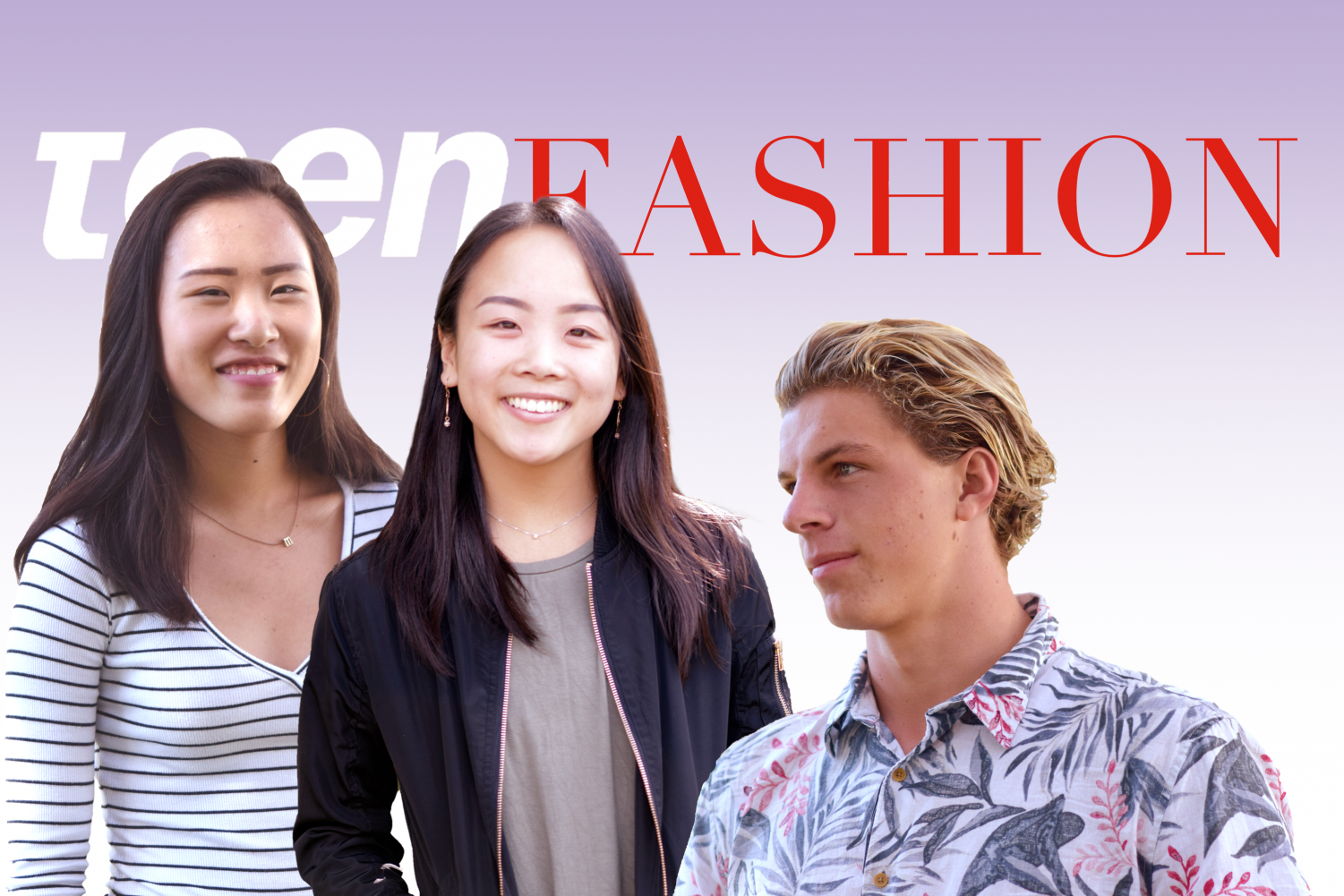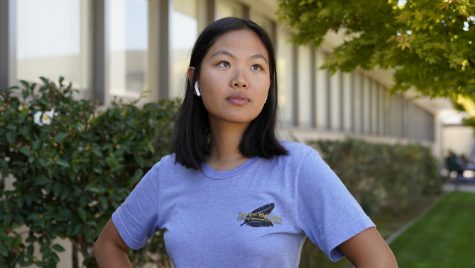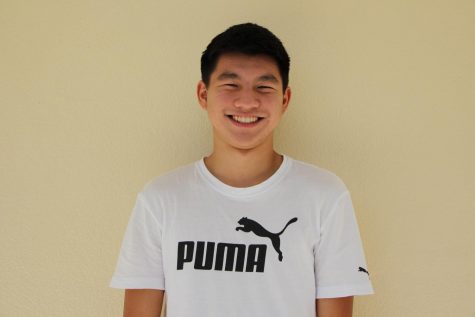Teen Fashion
More than keeping warm, what does clothing mean to us?
October 23, 2017
Style with Kyle: Hair is independence
For senior Kyle Sandell, hair is a “visual expression” of himself — his love of water polo and his development as a person. Hours of spending time in chlorine-filled pools and under the bright sun has made his hair bleached and blond like most other water polo players at Los Altos. But unlike his teammates on the varsity water polo team, Kyle has, by far, the longest hair.
Kyle’s locks are the result of a bet with his friend last year. After Kyle started growing his hair for a few weeks, he decided he liked the look of it. But his decision to grow out his hair has not always been met with support, especially by his parents.
“[My parents] even tried to pay me to get my hair cut again,” Kyle said.“My mom was like ‘I will give you $70 to get your hair cut back to normal.’ And I just stuck with this because I like it [and] it’s my decision… Now it gives her something to poke fun at.”
To Kyle, hair isn’t just dead skin cells on top of his head — it exists as a symbol of his independence.
“My fashion was very defined by my parents for some time,” Kyle said. “I wore what they bought me, I cut my hair how they told me to get it cut and I just did that. And then [my hair] was the one thing that I kind of started doing myself… like I’m going to do my hair like this and I’m not getting a number three buzz cut.”
Further, Kyle’s hair symbolizes his independence from society’s standards. In a world where man buns are dying and undercuts are on the rise, long hair is becoming rarer and rarer for men. Even though Kyle will continue to grow his hair out as a high schooler, he admits that when he grows older his hair probably won’t grow longer.
“I feel like having longer hair on guys isn’t the social norm,” Kyle said. “A lot of people keep their hair relatively short and when I’m an adult if I decide to cut it short it’ll be kind of a compliance thing… Having longer hair as you get older is kind of weird, you just start looking like Snape. ”
Carissa Lee & Jasmine Shen: A medium for “Esthetiq”
Carissa
ESTHETIQ started from procrastination. Over the summer, I was bored and uninterested in writing college applications. Instead, my goal for the summer was to start a clothing line as an enjoyable way to earn some extra income. ESTHTIQ was the result.
With my mother’s encouragement, I printed a sample shirt with the tentative logo of my original brand and sent a photo to my friend and fellow artist, Jasmine. Her response was enthusiastic, to say the least. Our weekly college application meetings became brand brainstorm sessions as we abandoned productivity for the infinitely more exciting pursuit of starting a fashion label. Within two weeks, we had established a label, a handful of designs and ordered a test batch of shirts to print.
I took inspiration for our shirts from street fashion photoshoots. I imagined how the shirts would complement other articles of clothing, and I created designs with versatility in mind. But, rather than focusing solely on elements of fashion, my designs are more reminiscent of the contemporary art found in museums like MoMA. Artists like Keith Haring and Jason Polan encouraged me to develop a scribbly, loose style. I also played around creating stark and simple black lines that emphasize the minimalistic elements of our brand identity.

Jasmine:
The screen-printing process for our clothing line was no cake walk. We purchased a cheap kit and relied on YouTube videos to guide us. The whole endeavor cost us a hefty $150 for mixed results. But, as we’ve learned, entrepreneurship is all about trial and error. While we successfully screen-printed one design, it was clear that a more efficient, made-to-order printing method would be required.
I base my ideas off casual street fashion to create comfortable, simplistic designs to appeal to a wider audience. Unlike Carissa, I don’t have any specific artists that I model, rather I’m influenced by trends as a whole.
For example, I try and work toward the likes of Commes des Garcons, a fashion brand famous for its iconic heart logo. It’s a simple design, yet instantly recognizable and versatile. I strive to create a design that is equally discernible, but with my own personal touch. Another influence, or more accurately, an anti-influence, was seeing overused concepts on graphic tees, namely those bearing the words “SLAY” or “SAVAGE.” It was a constant, frustrating search for simple graphic apparel that had designs with real thought and effort put into them — real art instead of meaningless phrases. I’ve tried to make sure we analyze the current trends and incorporate them into our graphics without sacrificing our integrity. More and more people are looking for eye-catching designs that aren’t overly complicated or generic, and I believe our brand exists to meet those demands.
Cathy Wang: From Cargo Pants to Cardigans
If you met me two years ago, you would’ve found a girl hopelessly trying to scramble for a “cool girl” image and a nonchalant-ness that only made her a watered-down version of herself.
Growing up, I would watch the usual fare of kids programming and in each show, assaulted by images of the mean, popular girls in pink mini-skirts, done-up hair and glossy lips. On the other side was our hero: the girl who didn’t care about the clothes she wore or the makeup she put on. In the end, she was always the one that won.
I had to be Selena Gomez in “Another Cinderella Story,” with her giant cargo pants and horrendously long shirts. Selena didn’t care about how she looked, and she got to date the pop star. So maybe that’s how I was supposed to be.
What followed were years of carefully constructed indifference toward my appearance, ripe with ill-fitting graphic tees and nasty yoga pants and the belief that this constant discomfort would make me desirable. All it did, though, was present an image of a lukewarm girl.
By the age of thirteen I was tired of putting on this show of passivity. I was done changing my image to become someone who didn’t care about their image. I began to tentatively venture into a world I call: Wearing Clothes That Make Me Feel Pretty.
After six years of looking like a human trash bag it was easy for me to slip back into old habits: both because of the familiarity of the space I was in and the fear of kids who had known me since kindergarten calling attention to this change in the Cathy Brand. But when I moved here from the conservative and painfully white Kansas in July 2016, I was confronted by a place that was a stranger to me. Nobody knew me, so there were no pre-conceptions of the serious, apathetic Asian girl. I could become someone new.
The change was gradual and difficult. Before I knew it, I was the loud and talkative friend who wore dresses as often as they could and lived for the calm routine of putting on makeup. I’ve come to relish in the feeling of putting together an outfit and presenting to the world an image of the Cathy that I am now and always want to be — someone confident and someone ecstatic at the opportunity to wear a bright, yellow crop top.
Fashion can be chalked up to be a silly thing, especially when you look at arguments about male rompers or the monotony of the “who are you wearing” question on the red carpet. All of that, though, can’t discredit the confidence and security I feel in a nice outfit. It’s not just me, many going through tumultuous times like high school can gain some positivity from fashion.
I’ve come to find that fashion has become a way for me to show the progress I’ve made in growing up. I dress for myself and I love me and every bit of my happy, ‘trendy teen clothes, cares too much’ wardrobe.
The newest trend at Los Altos: Confidence and comfort
Trends and brands rule teen fashion, especially in an environment where kids struggle to fit in. But senior Lisa Deng and sophomore Megan Liu wear whatever makes them feel comfortable in their own skin.
Both Megan and Lisa see fashion as the way people present their personality to the world. They’ve found that confidence and fashion form a sort of symbiotic relationship: Lisa traces her fashion sense to her confidence, and Megan credits her newfound confidence to her fashion choices.
“I feel more confident in myself, and I’m able to get out of my comfort zone and express myself more in ways other than just clothing, like by speaking up during class and bringing up new ideas during discussions,” Megan said.
Although Lisa followed trends in middle school, she increasingly began experimenting with out of the box styles, as she grew up and gained self-confidence, even wearing a jumpsuit for Homecoming court.
“My fashion style is rooted in my personal confidence and being satisfied with where I am and not wanting to be anyone else,” Lisa said. “I know I’ll get judged because I look so different from everyone else, but I thrive on that challenge and personal risk.”
Like Lisa, Megan doesn’t adhere to a single category. She observes that many tend to confine themselves to one, whether it’s “grungy” or “minimalist,” as an effect of group mentality. She admits that “some teens feel like they need to follow trends or follow what everyone else at their school is wearing.” To Megan, these labels aren’t worth their limitations — they make people feel that their selection of trends to follow narrows.
Through her ventures, Megan has learned how her fashion choices can empower others and sees it as a large part of her life. She strives to dress in a way that promotes confidence in others as well as herself.
“It’s a big part of how I feel about myself a lot of the time, and so it makes me feel more sure of my decisions, Megan said. “[Fashion] helps me be more helpful to the people around me because it helps create synergy between people.”
On the other hand, Lisa understands that, while fashion may be a way for her to express herself, other people find confidence in other ways. At the end of the day, it all comes down to achieving a certain degree of confidence and comfort.
“I don’t think fashion’s that important if you’re comfortable with who you are,” Lisa said. “For me, fashion is an outlet and I feel comfortable doing that. For other people, fashion might not be their priority or the way they feel good. If you’re comfortable with who you are and happy with your life, then it doesn’t matter.”
Q&A with Professor Elizabeth Kessler
Elizabeth Kessler, a program coordinator in American Studies who teaches classes on the history of fashion at Stanford University, recently discussed teen fashion with The Talon . While her interests within 20th and 21st century American visual culture are quite broad, she maintains a passion for fashion and is currently working on a project on fashion photography.
Q: What separates teen fashion from other kinds of fashion?
A: While this isn’t the only thing, price can distinguish teen fashion. The styles shown on the runways of fashion week are often quite expensive, and they’re marketed to an older clientele. With the rise of fast fashion, however, clothes inspired by some of those runway looks are more available at less expensive prices.
Q: How have you seen fashion evolve over the year?
A: I think more people are paying attention to fashion today than ever before. Everything’s now online, making it much easier to see every look that walked the runways during fashion week in New York, London, Milan, and Paris. This wasn’t possible until the early 2000s and before that time, fashion shows were attended mostly by journalists, department store buyers and a few celebrities. Blogs, Instagram feeds and other forms of social media also make it easier to see what people are wearing on the street all around the world. And more attention is now paid to menswear, whereas in the past fashion largely meant women’s fashion.
Q: How has fashion media evolved over the years?
A: For most of the 20th century, fashion media was dominated by fashion magazines, especially Vogue and Harper’s Bazaar. But it was also covered by other print publications such as major newspapers and other news magazines; almost every city newspaper had a fashion reporter. Today, fashion magazines still have some influence, but very few newspapers cover fashion, mostly just the largest ones, such as the New York Times and the Washington Post. Fashion media is largely a digital endeavor, and Vogue, for example, has a large website that covers current fashion, as well as archives fashion shows from the last 15 years. And, of course, fashion blogs and Instagram feeds are very popular, allowing many more people to participate in the conversation around fashion.




